Taking action positive legionella results
Taking action positive legionella results Legionella bacteria pose a potential risk in all water systems, including those commonly found in sports facilities. To ensure the safety and well-being of athletes, staff, and visitors, it is crucial for the sports industry to implement effective control measures. Regular Legionella testing plays a significant role in assessing the efficacy of these measures. In this blog post, we will discuss the actions to be taken upon receiving a positive Legionella sample result, emphasizing the importance of a proactive approach to mitigate the risk of Legionella colonization and ensure water system safety.
Understanding Legionella Sample Results:
When receiving a Legionella sample result, it’s essential to interpret the findings correctly. A comprehensive certificate of analysis accompanies each result, providing vital information for subsequent actions.
Sample Details:
The certificate includes the location, date, and time of the sample collection. Additionally, it records the primary control measure at the time of sampling, usually indicating the temperature but potentially mentioning a chemical reserve such as Chlorine Dioxide or Silver reserve.
Detection of Legionella:
The Legionella sample result will indicate whether Legionella bacteria were detected or not. A “Detected” result signifies a positive finding, while a “Not detected” result indicates a negative outcome. The testing is typically conducted on a one-liter water sample.
Legionella Speciation:
Legionella species are further categorized based on their serogroups. The results will specify the detected species as one of the following options:
- L.pneumophila serogroup 1
- L.pneumophila serogroup 2-14
- L.species (other than L.pneumophila serogroup 1-14)
Legionella Enumeration:
The concentration of Legionella in the water sample is reported as colony-forming units per liter (cfu/l). If a smaller sample volume was analyzed, the tested volume will be stated.
Taking action positive legionella results Assessing and Responding to Results
Upon receiving positive Legionella results, it is crucial to promptly assess the situation and take appropriate actions. The following steps will guide you through this process:
Assess the Results:
To gain clarity and inform subsequent actions, consider the following questions while reviewing the results:
- Why were the samples taken in the first place?
- Do the results pertain to a single water system or multiple systems? Identify the specific systems involved.
- Are the majority or minority of samples reported as “Detected” for each system?
- Are the enumeration results greater or less than 1,000 cfu/l?
- Is this the first positive result for each system, or are they failed re-samples?
Taking action positive legionella results Housekeeping and Risk Assessment
Regardless of the enumeration level, taking immediate action is crucial to address the situation effectively. Consider the following steps based on the enumeration level:
- a) Positive samples with enumeration less than 1,000 cfu/l
If the minority of samples are positive and these are the first failures, resample the system.
If the majority of samples are positive, it may indicate low-level colonization. Resample the system, conduct an audit of control measures, and review the water risk assessment. Water system disinfection may be necessary.
- b) Samples with enumeration greater than 1,000 cfu/l
If most samples are positive and exceed 1,000 cfu/l, consider system-wide disinfection.
Resample the system two to seven days after disinfection.
Review the number and locations of samples to ensure meaningful results. A well-designed sampling plan can aid in identifying root causes.
Review the water risk assessment to ensure it reflects the current state of the water system, including physical and operational factors.
Verify if all remedial actions and recommendations from the water risk assessment have been implemented.
Conduct an immediate review of control measures, including the logbook, to ensure scheduled tasks are completed and recorded satisfactorily for Legionella control.
- c) Samples with enumeration greater than 10,000 cfu/l:
In addition to the actions recommended for enumeration levels exceeding 1,000 cfu/l, consider removing affected outlets or systems from service.
Implement a comprehensive flushing regimen for removed outlets/systems to prevent further issues.
Follow-up and Escalation:
Legionella pneumophila is persistent and can be challenging to eradicate once it establishes a foothold. Maintain detailed records of all actions taken in response to positive results. These records serve as evidence for closing out positive results and provide insights for addressing persistent colonization issues.
Repeated failures should follow an iterative cycle of plan, do, check, act. It is crucial to involve duty holders and senior management at an early stage to ensure adequate resources and authority for resolving the issue. Addressing Legionella colonization should never fall solely on the responsibility of a single individual.
 Taking action positive legionella results Taking immediate action upon receiving positive Legionella sample results is vital for the sports industry to maintain a safe and healthy environment. By following the outlined assessment and response steps, sports facilities can effectively mitigate the risk of Legionella colonization. Remember, Dantek are experts in Legionella prevention and control and can provide valuable assistance throughout the assessment and eradication process.
Taking action positive legionella results Taking immediate action upon receiving positive Legionella sample results is vital for the sports industry to maintain a safe and healthy environment. By following the outlined assessment and response steps, sports facilities can effectively mitigate the risk of Legionella colonization. Remember, Dantek are experts in Legionella prevention and control and can provide valuable assistance throughout the assessment and eradication process.
Prioritize the safety of your athletes, staff, and visitors by proactively managing Legionella in your water systems.
Contact the Dantek team today. You can give us a call at 01454 417 920 https://www.dantekenvironmental.co.uk/contact-us/ or send an email to sales@dantek.co.uk. We’re here to assist you and answer any inquiries you may have.
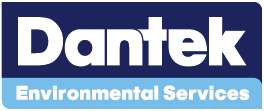
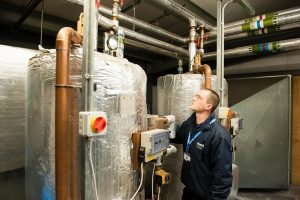

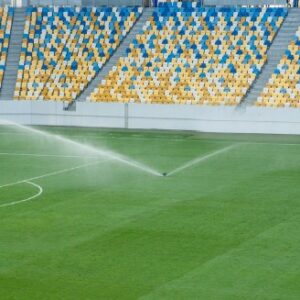 In the world of sports, maintaining pristine playing conditions is of utmost importance. From football and cricket to golf and tennis, the quality of the pitch can greatly impact the performance and safety of athletes. One essential component in maintaining these optimal conditions is the irrigation systems. However, it is crucial to recognize that irrigation systems can also pose potential health risks if not properly managed, specifically when it comes to Legionella contamination.
In the world of sports, maintaining pristine playing conditions is of utmost importance. From football and cricket to golf and tennis, the quality of the pitch can greatly impact the performance and safety of athletes. One essential component in maintaining these optimal conditions is the irrigation systems. However, it is crucial to recognize that irrigation systems can also pose potential health risks if not properly managed, specifically when it comes to Legionella contamination.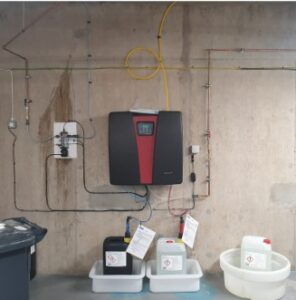 As experts in water hygiene and Legionella risk management, Dantek provides effective solutions for maintaining clean and safe water systems in sports facilities. In the sports industry, controlling Legionella in water systems is crucial to protect the health and well-being of athletes, staff, and visitors. While temperature control is often the primary method, situations may arise where it is not feasible to control the risk with this method. In these situations, Chlorine dioxide is a highly effective means of control that can be used to make water systems safe to use once again.
As experts in water hygiene and Legionella risk management, Dantek provides effective solutions for maintaining clean and safe water systems in sports facilities. In the sports industry, controlling Legionella in water systems is crucial to protect the health and well-being of athletes, staff, and visitors. While temperature control is often the primary method, situations may arise where it is not feasible to control the risk with this method. In these situations, Chlorine dioxide is a highly effective means of control that can be used to make water systems safe to use once again.
 Top 5 problems with legionella risk assessments!
Top 5 problems with legionella risk assessments!
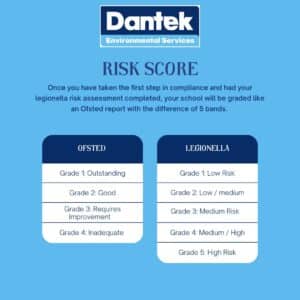
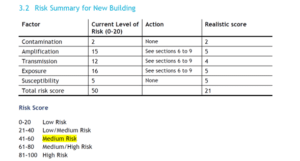

 Contact us for more information or to book a free demonstration.
Contact us for more information or to book a free demonstration. Our website is a great tool for local services, FAQs, sectors, and price guides. please visit
Our website is a great tool for local services, FAQs, sectors, and price guides. please visit